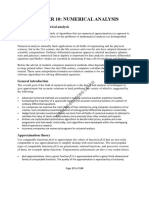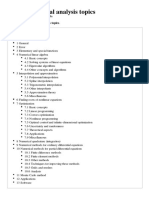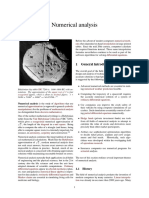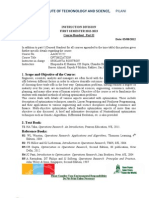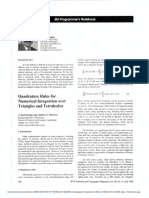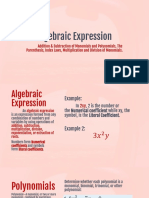Numerical Approximation Algorithms
Uploaded by
Frank BenNumerical Approximation Algorithms
Uploaded by
Frank Benapproximation algorithms are efficient algorithms that find approximate solutions to optimization
problems (in particular NP-hard problems)(non-deterministic polynomial-time hardness) with
provable guarantees on the distance of the returned solution to the optimal one.
an optimization problem is the problem of finding the best solution from all feasible solutions.
Optimization problems can be divided into two categories, depending on whether the variables are
continuous or discrete
The Christofides algorithm or Christofides–Serdyukov algorithm is an algorithm for finding
approximate solutions to the travelling salesman problem, on instances where the distances form a
metric space (they are symmetric and obey the triangle inequality).[1] It is an approximation
algorithm that guarantees that its solutions will be within a factor of 3/2 of the optimal solution
length,
Approximation algorithms naturally arise in the field of theoretical computer science as a
consequence of the widely believed P ≠ NP conjecture. Under this conjecture, a wide class of
optimization problems cannot be solved exactly in polynomial time (An algorithm is said to be of
polynomial time if its running time is upper bounded by a polynomial expression in the size of the
input for the algorithm). The field of approximation algorithms, therefore, tries to understand how
closely it is possible to approximate optimal solutions to such problems in polynomial time.
However, there are also many approximation algorithms that provide an additive guarantee on the
quality of the returned solution. A notable example of an approximation algorithm that provides both
is the classic approximation algorithm of Lenstra, Shmoys and Tardos[2] for scheduling on unrelated
parallel machines.
Numerical analysis is the study of algorithms that use numerical approximation (as opposed to
symbolic manipulations) for the problems of mathematical analysis (as distinguished from discrete
mathematics). Numerical analysis naturally finds application in all fields of engineering and the
physical sciences, but in the 21st century also the life sciences, social sciences, medicine, business and
even the arts have adopted elements of scientific computations.
(predicting the motions of planets, stars and galaxies); numerical linear algebra is important for data
analysis;[2][3][4] stochastic differential equations and Markov chains are essential in simulating living
cells for medicine and biology.
The overall goal of the field of numerical analysis is the design and analysis of techniques to give
approximate but accurate solutions to hard problems, the variety of which is suggested by the
following:
Advanced numerical methods are essential in making numerical weather prediction feasible.
Computing the trajectory of a spacecraft requires the accurate numerical solution of a system of
ordinary differential equations.
Car companies can improve the crash safety of their vehicles by using computer simulations of car
crashes. Such simulations essentially consist of solving partial differential equations numerically.
Hedge funds (private investment funds) use tools from all fields of numerical analysis to attempt to
calculate the value of stocks and derivatives more precisely than other market participants.
Airlines use sophisticated optimization algorithms to decide ticket prices, airplane and crew
assignments and fuel needs. Historically, such algorithms were developed within the overlapping field
of operations research.
Insurance companies use numerical programs for actuarial analysis.
Direct and iterative methods
Discretization and numerical integration
You might also like
- M.J.D. Powell - Approximation Theory and Methods-Cambridge University Press (1981)No ratings yetM.J.D. Powell - Approximation Theory and Methods-Cambridge University Press (1981)351 pages
- Some Applications: Numerical Analysis Overall Goal Is The DesignNo ratings yetSome Applications: Numerical Analysis Overall Goal Is The Design3 pages
- Numerical Methods Is An Area of Mathematics and Computer Science That CreatesNo ratings yetNumerical Methods Is An Area of Mathematics and Computer Science That Creates7 pages
- Computational Biology As Another ScientiNo ratings yetComputational Biology As Another Scienti55 pages
- Introduction To Numerical Analysis With ExamplesNo ratings yetIntroduction To Numerical Analysis With Examples36 pages
- List of Numerical Analysis Topics, The Free EncyclopediaNo ratings yetList of Numerical Analysis Topics, The Free Encyclopedia28 pages
- Chapter - 2: Fundamentals of Algorithmic Problem SolvingNo ratings yetChapter - 2: Fundamentals of Algorithmic Problem Solving23 pages
- The Design of Approximation Algorithm 2011 PDFNo ratings yetThe Design of Approximation Algorithm 2011 PDF500 pages
- Weighted Superposition Operators in SomeNo ratings yetWeighted Superposition Operators in Some192 pages
- Numerical Analysis: From Wikipedia, The Free EncyclopediaNo ratings yetNumerical Analysis: From Wikipedia, The Free Encyclopedia23 pages
- ApproximationOperators Syllabus Maths AMUNo ratings yetApproximationOperators Syllabus Maths AMU3 pages
- Numerical Methods For Partial Differential Algebraic Systems of EquationsNo ratings yetNumerical Methods For Partial Differential Algebraic Systems of Equations61 pages
- The Design and Analysis of Approximation Algorithms: Facility Location As A Case StudyNo ratings yetThe Design and Analysis of Approximation Algorithms: Facility Location As A Case Study13 pages
- OPERATOR LEARNING ALGORITHMS AND ANALYSISNo ratings yetOPERATOR LEARNING ALGORITHMS AND ANALYSIS36 pages
- Instant Download Numerical Methods and Optimization in Finance 2nd Edition Manfred Gilli - Ebook PDF PDF All Chapters100% (3)Instant Download Numerical Methods and Optimization in Finance 2nd Edition Manfred Gilli - Ebook PDF PDF All Chapters41 pages
- Jacobi Method: Description Algorithm Convergence ExampleNo ratings yetJacobi Method: Description Algorithm Convergence Example6 pages
- Design and Analysis of Approximation Algorithms 1st edition by Ding Zhu Du, Ker Ko, Xiaodong Hu ISBN 1489998446 9781489998446 pdf download100% (1)Design and Analysis of Approximation Algorithms 1st edition by Ding Zhu Du, Ker Ko, Xiaodong Hu ISBN 1489998446 9781489998446 pdf download42 pages
- Radial Basis Functions Theory and ImplementationsNo ratings yetRadial Basis Functions Theory and Implementations14 pages
- Basic Techniques of Approximation AlgorithmsNo ratings yetBasic Techniques of Approximation Algorithms4 pages
- Computational Geometry: Exploring Geometric Insights for Computer VisionFrom EverandComputational Geometry: Exploring Geometric Insights for Computer VisionNo ratings yet
- Nonlinear Dynamic in Engineering by Akbari-Ganji’S MethodFrom EverandNonlinear Dynamic in Engineering by Akbari-Ganji’S MethodNo ratings yet
- Answer To Operation Research Assignment (AOR)No ratings yetAnswer To Operation Research Assignment (AOR)21 pages
- Pilani Pilani Campus: Birla Institute of Techonology and ScienceNo ratings yetPilani Pilani Campus: Birla Institute of Techonology and Science4 pages
- Knapsack Problem Using Dynamic Problem SolvingNo ratings yetKnapsack Problem Using Dynamic Problem Solving8 pages
- Quadrature Rules For Numerical Integration Over Triangles and TetrahedraNo ratings yetQuadrature Rules For Numerical Integration Over Triangles and Tetrahedra3 pages
- Functions of One Real Variable - DPP 15 (Of Lec 20) - Saakaar Batch For IIT JAM MathematicsNo ratings yetFunctions of One Real Variable - DPP 15 (Of Lec 20) - Saakaar Batch For IIT JAM Mathematics4 pages
- Algebra - I - DPP 01 - IOQM Booster Batch 2024No ratings yetAlgebra - I - DPP 01 - IOQM Booster Batch 20243 pages
- Microsoft Power Point History of MathematicsNo ratings yetMicrosoft Power Point History of Mathematics11 pages
- Dokumen - Pub Numerical and Statistical Methods For Computer Engineering Gujarat Technological University 2017 2nbsped 9789352604852 9352604857No ratings yetDokumen - Pub Numerical and Statistical Methods For Computer Engineering Gujarat Technological University 2017 2nbsped 9789352604852 9352604857598 pages
- Uncertainty Modeling for Engineering Applications Flavio Canavero 2024 Scribd Download100% (1)Uncertainty Modeling for Engineering Applications Flavio Canavero 2024 Scribd Download55 pages
- (Ferreira, 2009) Matlab Codes For Finite Element AnalysisNo ratings yet(Ferreira, 2009) Matlab Codes For Finite Element Analysis249 pages
- Cholesky Factorization: Positive de Nite MatricesNo ratings yetCholesky Factorization: Positive de Nite Matrices9 pages
- Lecture Notes On Mathematical Olympiad Courses For Junior Section Vol. 1No ratings yetLecture Notes On Mathematical Olympiad Courses For Junior Section Vol. 112 pages
- Group 1: Noorfadzlina Binti Hassan (Ta18003) Zul Izwan Bin Radzak (Ta18017) Gunalan A/L Sanasie (Ta18011)No ratings yetGroup 1: Noorfadzlina Binti Hassan (Ta18003) Zul Izwan Bin Radzak (Ta18017) Gunalan A/L Sanasie (Ta18011)42 pages
- Buy ebook Operations Research Principles and Applications 1st Edition G. Srinivasan cheap price100% (3)Buy ebook Operations Research Principles and Applications 1st Edition G. Srinivasan cheap price71 pages
- Solutions of Equations in One Variable The Bisection MethodNo ratings yetSolutions of Equations in One Variable The Bisection Method17 pages
- Practical Methods for Optimal Control and Estimation Using Nonlinear Programming Second Edition Advances in Design and Control John T. Betts All Chapters Instant Download100% (4)Practical Methods for Optimal Control and Estimation Using Nonlinear Programming Second Edition Advances in Design and Control John T. Betts All Chapters Instant Download61 pages
- Chapter Seven: Solution of Pdes. by Using Finite Difference Method 7.1 Partial Differential EquationsNo ratings yetChapter Seven: Solution of Pdes. by Using Finite Difference Method 7.1 Partial Differential Equations10 pages
- A-Generalized-Reduced-Gradient-Algorithm-for-Solving-Large_1989_IFAC-ProceedNo ratings yetA-Generalized-Reduced-Gradient-Algorithm-for-Solving-Large_1989_IFAC-Proceed6 pages








